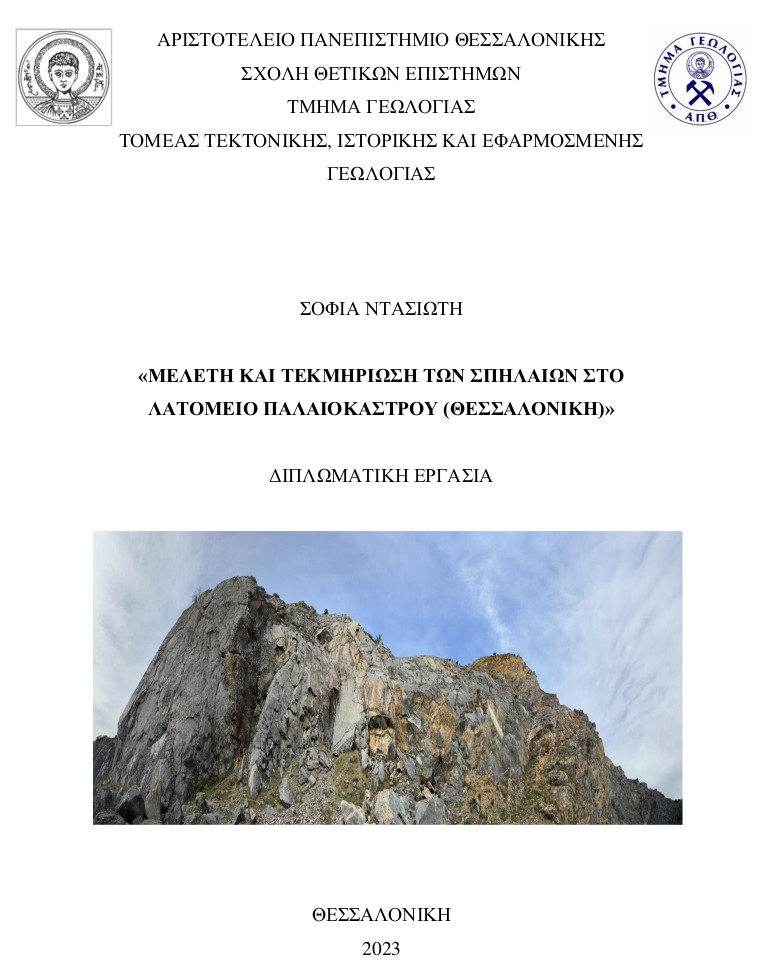
Μελέτη και τεκμηρίωση των σπηλαίων στο λατομείο Παλαιοκάστρου (Θεσσαλονίκη) = Study and documentation of the caves in Paleokastro qyarry (Thessaloniki).
Περίληψη
In Greece, karst phenomena, and especially caves, are an integral part of the Earth’s natural beauty. Many researches have been conducted based on the study of karst evolution, which have helped to understand, document and exploit caves. In particular, this project concerns the documentation of the cave in the Paleokastro’s quarry, in Thessaloniki. Based on the karst evolution, a theory was developed regarding the way this karst cavity created and the factors that contributed to the cave. During the formation of the cave, processes such as dissolution and erosion of permeable rocks take place, resulting in the creation of empty spaces. Chemical sediments that accumulate over time and form solid structures are called speleothems, which are included in the characteristic features of a cave. The development of these cave deposits is analysed and mapped using 3D scanning, which documents the depositional forms found in the karst cavity. Furthermore, the lithostratigraphic and tectonic evolution of the area are analysed, which are additional facts in determining the way that the caved developed and the prevailing tectonic conditions. To sum up, in this project are carried out the recording and documentation of the morphological structures, the tectonic conditions and the way of development of the Paleokastro’s cave, in Thessaloniki.
Πλήρες Κείμενο:
PDFΑναφορές
Antonelou, A., & Tsikouras, B., & Papoulis, D., & Hatzipanagiotou, K. (2017). Investigation of the formation of speleothems in the Agios Georgios cave, Kilkis (N. Greece). Bulletin of the Geological Society of Greece. 43(2), 876 - 885.
Bogli, A. (1978). In book: Karsthydrographie und Physische Spelaeologie., Springer Verlag, Heidelberg.
D’ Angeli, I., & De Waele, J., & Parise, M., & Vattano, M., & Madonia, G. (2022). Dissolution – Corrosion measurements with limestone and gypsum tablets in active sulphuric acid caves of southern Italy. 18th International Congress of Speleology. IV, 177 - 180.
De Waele, J., & Gutierrez, F. (2022). Cave Geomorphology. In book: Karst Hydrogeology, Geomorphology and Caves.
De Waele, J., & Frau, F., & Caddeo G. A., & Railsback, L.B. (2015). Stable isotope data as constraints on models of coralloid and massive speleothems: The interplay of substate, water supply, degassing and evaporation. 318, 130 - 141.
Ford, D & Williams, P. D. (2007). Karst Hydrogeology and Geomorphology. John Wiley & Sons. 1 – 562.
Frisia, S., & Borsato, A., & Fairchild I., & McDermott, F. (2000). Calcite fabrics, Growth mechanisms and Environments of formation in speleothems from the Italian Alps and Southwestern Ireland. Journal of Sedimentary Research. 70(5), 1183 - 1196.
Hill C. A. & Forti, P. (1997). Cave minerals of the world. (2nd ed). National Speleological Society, Huntsville.
Kalantari, B., & Jamali, H., (2015). A study in various techniques, advances, and issues for rock masses. International Journal of Research in Engineering and Science (IJRES). 3 (6), 12 - 20.
Lazaridis, G. (2022). Definition and Process – based classification of caves. Acta Carsologica. 51(1), 65 - 77.
Moore, G. W. (1952). Speleothem – a new cave term. National Speleological Society News. 10 (6), 2.
Rode, S., & Kadam, A., & More, K., & Fernandes, F., & Heber G. (2019). Design and development of 3d scanner. 1 - 5.
White, W. B. (1988). Geomorphology and hydrology of karst terrains. New York. Oxford University Press.
Ελληνική βιβλιογραφία
Αγγελόπουλος, Ν. (2012). Διαδικασία τρισδιάστατης σάρωσης και επεξεργασίας δεδομένων με ειδικό λογαριασμό. Διπλωματική εργασία, Κρήτη.
Βαξεβανόπουλος, Μ. (2006). Τεκτονικές συνθήκες σπηλαιογένεσης στο σπήλαιο Μελισσότρυπα Κεφαλοβρύσου Ελασσόνας. Διατριβή ειδίκευσης. Θεσσαλονίκη. 38 - 62.
Βασιλονικολός, Ε. (2013). Χρήση μορφομετρικών δεικτών για τον προσδιορισμό σπηλαιογενετικών διεργασιών σε σπήλαια της Β. Ελλάδος. Διπλωματική εργασία. 6 - 8.
Γιαννόπουλος Β., (2000). Συμβολή στη μελέτη σύγχρονων και παλαιών περιβαλλόντων των πλέον σημαντικών ελληνικών σπηλαίων. Διδακτορική διατριβή. Εθνικό και Καποδιστριακό Πανεπιστήμιο Αθηνών.
Γκολούμποβιτς – Δεληγιάννη Μ., (2019). Περιβαλλοντική καρστική γεωμορφολογία. Εκδοτικός Όμιλος Ιων. 26 - 27.
Μουντράκης, Δ. Μ. (2010). Γεωλογία και Γεωτεκτονική Εξέλιξη της Ελλάδας. Θεσσαλονίκη, University Studio Press (2η εκδ). 69 -70.
Μυρμηγιάννης, Ι. (2005). Μοντελοποίηση Καρστικού Σπηλαίου στα πλαίσια Ανάδειξης και Προβολής Φυσικών Πόρων. Διπλωματική Εργασία, Κρήτη, 15 - 34.
Τρανός, Μ. (2011). Μάθημα : Χαρτογραφήσεις Υπαίθρου, Αριστοτέλειο Πανεπιστήμιο Θεσσαλονίκης.
Τρίμμης, Π. Κ. (2013). Αρχαιολογία σπηλαίων και Γεωγραφικά συστήματα πληροφοριών. Μεταπτυχιακή Διατριβή, Θεσσαλονίκη, 11.
Διαδικτυακές πηγές
Bulletin of the Geological Society of Greece, https://www.researchgate.net/journal/Bulletin-of-the-Geological-Society-of-Greece-2529-1718, προσπελάστηκε 8/2023.
th International Congress of Speleology, 2022, http://uis-speleo.org/index.php/event/18th-international-congress-of-speleology-2/, προσπελάστηκε 8/23.
Sedimentary Geology, https://www.researchgate.net/journal/Sedimentary-Geology-0037-0738, προσπελάστηκε 8/23.
Journal of Sedimentary Research, https://www.researchgate.net/journal/Journal-of-Sedimentary-Research-1938-3681, προσπελάστηκε 8/23.
Acta Carsologica, https://www.researchgate.net/journal/Acta-Carsologica-Karsoslovni-Zbornik-1580-2612, προσπελάστηκε 8/23.
National Speleological Societ News, https://caves.org/nssnews/, προσπελάτηκε 8/23.
Εισερχόμενη Αναφορά
- Δεν υπάρχουν προς το παρόν εισερχόμενες αναφορές.
